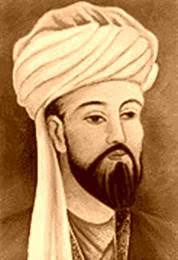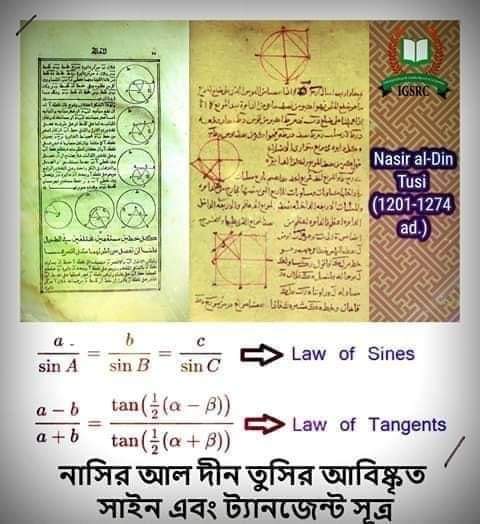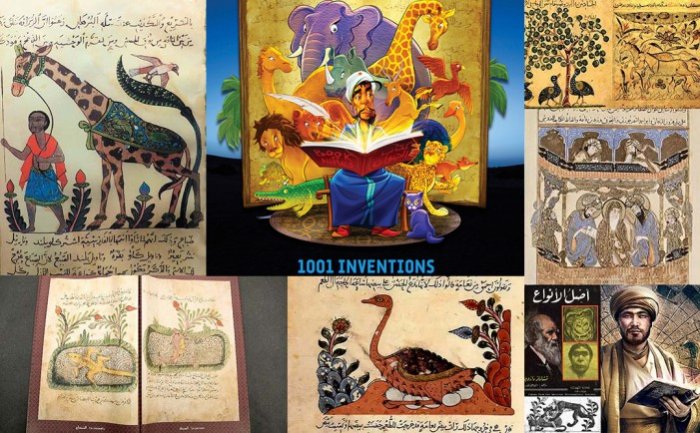Assalamu Alaikum
I hope you are all well by the grace of God.
All my previous episodes: -
13. Nasir al-Din al-Tusi (creator of trigonometry, inventor of the Jiz-Ilkhani data)
Newton Nasir Uddin Tusi was a philosopher, mathematician, physician, astronomer, poet, and politician. He was born in February 1201 in Tus Nagar, Kherson. His full name was Abu Jafar Muhammad ibn al-Hasan Nasir Ali Tusi al-Mahakkik. He is better known as Al-Tushi.
Al-Tushi gained unparalleled popularity and fame. He gained a reputation for his extraordinary knowledge. He is a unique figure in the world of mathematics. He was also able to acquire profound knowledge in medical science.
His knowledge of jurisprudence and ethics was also immense. Towards the end of his life, he achieved extraordinary success. His contribution to astronomy is immeasurable. His contribution to trigonometry is similar. He went to the famous scholar Kamal Uddin Ibn Yusuf and the famous contemporary scientists and philosophers of that time. Get the opportunity to learn.
Tusi's career began with various events. When the Mongols invaded Tus in 1230, al-Tusi fled and took refuge in the fort of Isma'ili. There he spent the next 25 years doing various research and observations.
In 1256, the Mongols, led by Halaku Khan, captured Isma'ili and captured al-Tusi. However, fascinated by Tusi, Halaku Khan appointed Tusi as his advisor.
A new chapter in Al Tusi's life begins with Halaku Khan. He persuaded Hulegu Khan in 1259 to establish the most advanced observatory in Azerbaijan, which still exists today. During this time he observed the sky at night as well as translating the works of scientists and astronomers such as Archimedes, Ptolemy, Hypothesis, Autolikas, Menelaus, Theodosius during the day.
From this observatory he attempts to make a perfect astronomical table by observation, so that accurate astrological calculation can be made. In his book 'Jiz-i-Ilkhani' he made a very accurate chart of the movements of the planets and stars, which was considered to be the most accurate table of his time.
Moreover, to the east of Copernicus' heliocentric solar model, Al Tusi's solar model was the most advanced and widely used model. So al-Tusi was more popular with Muslims than Ptolemy.
Haku Khan ordered Tusi to prepare a jigsaw about astronomy and other necessary sciences. Tusi Apase settled with Halaku Khan for 12 years instead of 30 years.
Eventually, he invented an astronomical database. This data serves as an asteroid for future astronomy. Even Copernicus had to rely on his data. Its inventor dedicated this data to its patron. The indomitable Halaku Khan was also known as Il-Khan. That is why this database is called Jij ilKhani.
Al Tusi was also able to successfully measure the annual ionization of the equator. Moreover, Tusi played a role in the development of the Astrolab instrument. However, Tusi's observation of our Milky Way galaxy was remarkable.
He said that the Milky Way galaxy is made up of countless tiny, faint light stars (distant stars seem faint to faint) that are clustered very Close together. Three centuries after his observation, Galileo observed with his own telescope that his galaxy was actually made up of countless faint stars of light. However, the observation of distance was wrong. Because now we know that the distance between the stars is much greater.
This was the first person to be able to catch the errors of Ptolemy's astronomy. He also revises them. Copernicus followed suit. Tusi's book on jurisprudence makes Al-Tushi's name widely known.
The name of this book was: Akhlak-E-Namiree. The knowledge of this book has been the source of knowledge of the students for centuries. It was a famous book. The book also gained tremendous popularity. He has written a creative book on Islamic philosophy. Its name: Tajrid-al-Akhlak. This book was also very popular.
In the time of al-Tusi, trigonometry was not considered a separate branch of mathematics. Rather, trigonometry was also considered a branch of astronomy for its highly effective use in astronomy.
Al-Tusi changed this notion by writing Treatises on Quadrilateral. He wrote this remarkable book on spherical trigonometry only, excluding astronomy altogether. And that is why trigonometry is separated from astronomy and established as its own branch of pure mathematics.
Al-Tusi was the first to make a list of six separate triangles in spherical trigonometry. His greatest achievements in trigonometry, however, were the discovery of the Law of Signs for the spherical triangle and the Law of Tangents. Al-Tusi not only made the discovery but also gave evidence in favor of these two sources. We are all familiar with these two formulas for the sake of high school math books.
Tushi's contribution to other branches of science is astounding. The following statement gives an idea of the depth of his knowledge. As Al Tusi said,
“An object or entity cannot completely disappear under any circumstances. It only changes its structure, condition, size, color, and other external or internal religions. ”
By this statement al-Tusi, at the same time, supports the principle of the immortality of the energy of physics and the principle of the permanence of the mass of chemistry!
In logic, he was a staunch supporter of Ibn Sina. He wrote a commendable essay on Ibn Sina's Ishrat, entitled Sharh al-Ishrat.
Charles Darwin's Natural Selection was published in 1859. Al-Tusir discussed some of the basics of evolution almost 800 years ago! Darwin also acknowledged Al Tusi's work in his book The Origin of Species, which is unknown to most.
Al-Tusi's discussion of evolution in his book Akhlaq-i-Nasri is, of course, different from Darwin's. Because he emphasized the creation of the universe and its evolution, where Darwin discussed the evolution of animals.
According to Tusi, the universe was formed at the beginning of creation with the same amount and the same matter. But quickly internal inconsistencies begin and changes between different substances begin. Changes in some substances happen quickly and in different ways. And because of this difference in change, different substances evolved and minerals, trees, animals, human beings were created. He also explains the need for hereditary variability for biological evolution. Tusi also discusses how animals adapt to hostile environments.
To clarify the issue of adaptation, Tusi draws on the example of the animals around him. In order to sustain and defend life, they have organs that act like real weapons. Horns that act like spears; The teeth and claws act as knives; The hooves work like a hammer. Again, animals that do not have such organs have a keen intellect and the ability to escape quickly, such as foxes, to survive adverse conditions. Again, animals that do not have the ability to escape quickly, they live in groups to deal with the enemy, such as ants.
According to al-Tusi, there are three types of living things on earth - trees, animals, and humans. He has placed people in different classes. Because, according to him, man is in the middle of an evolution. His explanation of human evolution-
“Some of the characteristics of man distinguish him from all other living things, some of the characteristics that make him look like an animal, some of the characteristics that reflect the characteristics of the tree. All this is evidence that man is slowly changing and moving towards perfection. Previously, the only difference was in the nature of the animal. The difference then builds up the power of observation and knowledge. Spiritual purity will make a difference one day. Humans are still associated with lower-class animals. But through their own efforts, they will one day attain spiritual purity and reach higher levels. ”
The number of books on his discoveries and inventions is unknown. According to Brookman, his books number 57. Shorten says the number is 84. One-fourth of it is related to astronomy. The rest is about other things. The books are in Arabic and Persian. These have been translated into Latin and other European languages. These can be found in printed form.
Science and philosophy cannot be discussed without Tushi. He went to Baghdad in his last life. One day this city was looted by its patron Halaku Khan. He probably died in 1264 AD. At his death, an alka vortex fell.










No comments:
Post a Comment